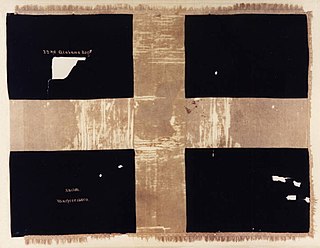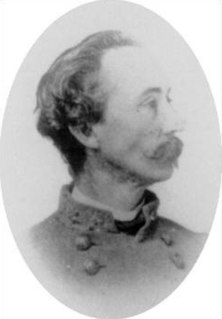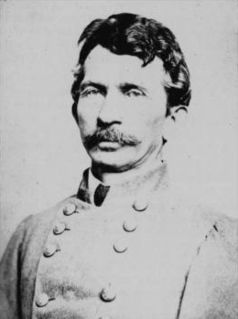Related Research Articles

The 22nd Alabama Infantry Regiment was an infantry regiment that served in the Confederate Army during the American Civil War.

Benjamin Lewis Hodge was a Confederate politician who commanded the 19th Louisiana Infantry Regiment during the early stages of the American Civil War, including during the Battle of Shiloh.

The 10th Mississippi Infantry Regiment was a regiment of infantry in the Confederate States Army during the American Civil War. It fought in several campaigns and battles in the Western Theater.
The 3d Arkansas Cavalry Regiment (1861–1865) was a Confederate Army Cavalry regiment during the American Civil War.
The 1st Missouri Infantry was an infantry regiment that served in the Confederate States Army during the American Civil War. Originally commanded by Colonel John S. Bowen, the regiment fought at the Battle of Shiloh, where it was engaged near the Peach Orchard on April 6, 1862. On April 7, during the Union counterattacks at Shiloh, the regiment was instrumental in preventing the Washington Artillery from being captured. The regiment was next engaged at the Second Battle of Corinth, where it outflanked several Union positions. On the second day at Corinth, the regiment was only minimally engaged. On November 7, the 1st Missouri Infantry was combined with the 4th Missouri Infantry to form the 1st and 4th Missouri Infantry (Consolidated), as a result of heavy battle losses in both regiments.

The 9th Arkansas Infantry Regiment was a regiment of the Confederate States Army during the American Civil War. It served in the Western Theater, seeing action in the Vicksburg, Tennessee and Georgia campaigns. Due to attrition; the 9th Arkansas was consolidated several times with other Arkansas regiments, finally merging in 1865 into the 1st Arkansas Consolidated Mounted Rifles.

The 1st Missouri Cavalry Regiment was a cavalry regiment that served in the Confederate States Army during the American Civil War.

The 10th South Carolina Infantry Regiment was a Confederate volunteer infantry unit from the state of South Carolina during the American Civil War. It fought with the Army of Tennessee in the Western Theater for the duration of the war. Originally organized to serve for twelve months it was reorganized for the war in 1862. Sent east to fight in the Carolinas Campaign in 1865 it was consolidated with the 19th South Carolina Infantry Regiment and formed Walker's Battalion, South Carolina Infantry. The unit surrendered with General Joseph E. Johnston and the Army of Tennessee at Bennett Place on April 26, 1865. Out of 2189 men listed on the regimental muster rolls throughout the conflict only 55 enlisted men remained to be paroled.

The 28th Louisiana Infantry Regiment was an infantry regiment from Louisiana that served in the Confederate States Army during the American Civil War. It was also known as Gray's Regiment to differentiate it from the 28th (Thomas') Louisiana Infantry Regiment, which was also numbered as 29th. Raised in 1862 it served in the Trans-Mississippi Theater and along the Gulf Coast until it disbanded in 1865.

The 9th Texas Infantry Regiment was a unit of Confederate States Army infantry volunteers organized in December 1861 that fought during the American Civil War. The regiment fought at Shiloh, Perryville, and Stones River in 1862, Chickamauga in 1863, the Atlanta Campaign, Allatoona, and Nashville in 1864, and Spanish Fort and Fort Blakeley in 1865. The remaining 87 officers and men surrendered to Federal forces in May 1865. Two of the regiment's commanding officers were promoted brigadier general.

The 3rd Louisiana Infantry Regiment was a unit of foot soldiers from Louisiana that fought in the Confederate States Army during the American Civil War. The regiment distinguished itself at Wilson's Creek in 1861. The 3rd Louisiana fought at Pea Ridge, First Corinth, Iuka, and Second Corinth in 1862. The unit defended Vicksburg in 1863 where it was captured. At Vicksburg, the unit's fortification was twice blown up by powerful land mines. The surviving soldiers were paroled and exchanged, after which they performed guard duty for the rest of the war.

The 1st Louisiana Regulars Infantry Regiment, often referred to as the 1st Louisiana Infantry Regiment (Regulars), was an infantry regiment from Louisiana that served in the Confederate States Army during the American Civil War.

The 21st Louisiana Infantry Regiment, also called the McCown Regiment, was an infantry regiment from Louisiana that served in the Confederate States Army during the American Civil War. Six of its companies formed the 5th Louisiana Infantry Battalion organized in September 1861, which fought in the Battle of Belmont as cannoneers. The battalion was brought up to regimental strength, becoming the 21st Louisiana, by the addition of four companies in February 1862. After service at Island Number Ten, Fort Pillow, and the Siege of Corinth, the regiment was disbanded due to its high desertion rate.
The 4th Missouri Infantry Regiment was formed on April 28, 1862, and served in the Confederate States Army during the American Civil War. The infantry regiment did not see action at the Battle of Farmington on May 9, and the Battle of Iuka on September 19 despite being part of the Confederate force present at those battles. As part of Brigadier General Martin E. Green's brigade, the regiment participated in three charges against Union lines on October 3, 1862, during the Second Battle of Corinth. The following day, the regiment, along with the rest of Green's brigade, attacked the new Union lines. Despite initial success, the attack was repulsed by a Union counterattack. The regiment ceased to exist as a separate unit when it was combined with the 1st Missouri Infantry Regiment on November 7, 1862, to form the 1st and 4th Missouri Infantry Regiment (Consolidated).
The 2nd Missouri Infantry Regiment was an infantry regiment that served in the Confederate States Army during the American Civil War. Organized on January 16, 1862, the regiment first saw major action at the Battle of Pea Ridge on March 7 and 8, 1862. After Pea Ridge, the regiment was transferred across the Mississippi River, fighting in the Battle of Farmington, Mississippi on May 9. The unit missed the Battle of Iuka in September, but was heavily engaged at the Second Battle of Corinth on October 3 and 4. The regiment helped drive in a Union position on October 3. On October 4, the 2nd Missouri Infantry, along with the rest of Colonel Elijah Gates' brigade, captured a fortification known as Battery Powell, but were forced to retreat by Union reinforcements.
The 3rd Missouri Infantry Regiment served in the Confederate States Army during the American Civil War. The infantry regiment was officially mustered into service on January 17, 1862. It fought at the Battle of Pea Ridge in Arkansas in March before being transferred across the Mississippi River. While stationed at Corinth, Mississippi, the regiment played a minor role in the Battle of Farmington before the evacuation of the town. In September, the unit saw light action at the Battle of Iuka before being heavily engaged during the Second Battle of Corinth as the Confederates attempted to retake the town in October. In early 1863, the regiment was transferred to Grand Gulf, Mississippi, in order to strengthen the defenses of the Mississippi River at that point. At the Battle of Grand Gulf on April 29, the unit helped repulse a Union Navy attack against the Confederate defensive works. After elements of the Union Army of the Tennessee landed below Grand Gulf, the regiment fought in a delaying action at the Battle of Port Gibson on May 1.

The 5th Missouri Infantry Regiment was an infantry regiment that served in the Confederate States Army during the American Civil War. The regiment entered into service on September 1, 1862, when the elements of two preceding battalions were combined. Many of the men entering the regiment had seen service with the secessionist Missouri State Guard. James McCown was the regiment's first colonel. After playing a minor role at the Battle of Iuka on September 19th, the regiment then fought in the Second Battle of Corinth on October 3rd and 4th. After being only lightly engaged on the 3rd, the regiment charged the Union lines on the 4th, capturing a fortification known as Battery Powell. However, Union reinforcements counterattacked and drove the regiment from the field. In early 1863, the regiment was transferred to Grand Gulf, Mississippi, where it built fortifications. The unit spent part of April operating in Louisiana, before again crossing the Mississippi River to return to Grand Gulf.

The 6th Louisiana Infantry Regiment served in the Confederate States Army during the American Civil War. It was part of the Louisiana Tigers. Formed in June 1861 at Camp Moore, it fought in Jackson's Valley campaign, the Battle of Gaines Mill, the Second Battle of Bull Run and its related actions, and the Battle of Antietam in 1862. The next year, it fought at the Second Battle of Fredericksburg, the Battle of Salem Church, the Second Battle of Winchester, and the Battle of Gettysburg before being overrun at the Second Battle of Rappahannock Station. It spent 1864 fighting in Grant's Overland campaign and with Jubal Early in the Valley campaigns of 1864. The regiment fought in the Battle of Hatcher's Run and the Battle of Fort Stedman in early 1865 before surrendering after the Battle of Appomattox Court House in April. It began its service with 916 men and ended with 52.

The 12th Louisiana Infantry Regiment was a unit of volunteers recruited in Louisiana that fought in the Confederate States Army during the American Civil War. Formed in August 1861, the regiment served in the Western Theater of the American Civil War and was unique in that there were 12 companies. The regiment garrisoned Island Number Ten before being stationed at Fort Pillow. It fought at Second Corinth in 1862 and Champion Hill and Jackson in 1863. A detachment served during the Siege of Vicksburg and was captured. In 1864, the regiment fought in the Meridian, Atlanta, and Franklin–Nashville campaigns, suffering heavy losses at Peachtree Creek and Franklin. It fought at Bentonville in 1865 before surrendering with General Joseph E. Johnston.

The 4th Louisiana Infantry Regiment was a unit of volunteers recruited in Louisiana that fought in the Confederate States Army during the American Civil War. Formed in May 1861, the regiment served in the Western Theater of the American Civil War. The unit fought at Shiloh and Baton Rouge in 1862 and at Jackson in 1863. A detachment served during the Siege of Port Hudson and was captured. In 1864, the regiment fought in the Atlanta campaign where it lost heavily at Jonesborough. At Nashville in December 1864 most of the men were captured. The survivors were consolidated with several other units and fought at Spanish Fort in April 1865. The remnant surrendered in May 1865.
References
Citations
- ↑ Salling 2010, p. 4.
- 1 2 Salling 2010, pp. 13–15.
- 1 2 3 4 5 Bergeron 1996, pp. 120–122.
- ↑ Durham 1979, pp. 177–178.
- ↑ Salling 2010, p. 223.
Bibliography
- Durham, Ken (Spring 1979). ""Dear Rebecca": The Civil War Letters of William Edwards Paxton, 1861-1863". Louisiana History. 20 (2): 169–196. JSTOR 4231889.
- Bergeron, Arthur W. (1996). Guide to Louisiana Confederate Military Units, 1861–1865. Baton Rouge: Louisiana State University Press. ISBN 0-8071-2102-9.
- Salling, Stuart (2010). Louisianians in the Western Confederacy: The Adams-Gibson Brigade in the Civil War. Jefferson, North Carolina: McFarland. ISBN 9780786456833.